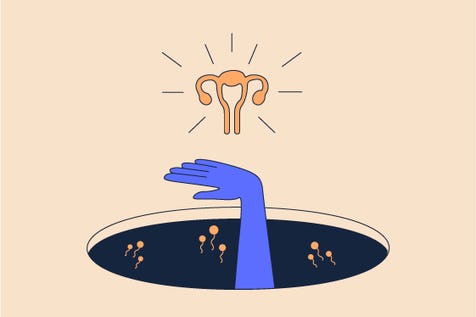The human body is made up of almost a hundred hormones. Each of them has its own unique function (1). As you might have guessed, during pregnancy, the body undergoes important hormonal changes. A few hormones are directly responsible for ensuring a healthy pregnancy and a successful birth: human chorionic gonadotropin (hCG), estrogen, progesterone, relaxin, human placental lactogen (hPL), prolactin and oxytocin (2).
The first of these, hCG, is often referred to as the pregnancy hormone. It is the hormone that is detected when you receive a positive pregnancy test.
Two more hormones which are essential for a healthy pregnancy are estrogen and progesterone. They are produced in the ovaries and fluctuate in concentration during the menstrual cycle. They help to prepare the uterus for pregnancy. Throughout your pregnancy, you will experience increased levels of both hormones.
Another important hormone at play is relaxin. It is a protein hormone produced by your ovary during pregnancy, that relaxes the pelvis when your body is ready for childbirth.
hPL (3) is a hormone responsible for maintaining a sufficient nutrition supply to the fetus. Prolactin, on the other hand, is the hormone responsible for the production of breast milk.
Finally, oxytocin is responsible for triggering contractions in the uterus during labor and delivery.

For some women, increased progesterone levels are linked to the mood swings they experience in their first trimester.
Hormone levels in the first trimester of your pregnancy
The most drastic hormonal changes will occur in your first trimester. You’ll witness a substantial increase in the production of progesterone and estrogen.
Progesterone is responsible for the thickening of your uterine lining so that an egg can implant. It also acts as a relaxant to prevent your uterus from contracting until your due date. For some women, increased progesterone levels are linked to the mood swings they experience in their first trimester.
Estrogen causes an increase in blood flow to the placenta. The placenta is a temporary organ created to connect the fetus to the uterine wall, allowing the uptake of nutrients, the elimination of waste, and other functions that are vital for embryo development (5). This increase in estrogen can lead to frequent urination and make your breasts feel tender. On the plus side, the increased levels of estrogen have also been attributed to being responsible for what is known as the “healthy pregnancy glow” (6).
hCG starts being produced in the first trimester. It plays a crucial part in establishing and maintaining pregnancy, through placentation - a technical word used to describe the formation of the placenta. In the first 10 weeks of pregnancy, your hCG levels double every two days (7). This rise is responsible for stopping your period and preparing the placenta for a baby. On the downside, rising levels of hCG often cause nausea and vomiting, what many women recognize as morning sickness.
Hormonal changes in the second trimester of pregnancy
In your second trimester, your body adjusts to the slew of new levels of hormones coursing through it. hCG levels start to decline. Some pregnancy symptoms you experienced in your first trimester, such as nausea, start to dissipate. Relaxin, the hormone responsible for relaxing the muscles in your pelvis to facilitate childbirth, begins to increase. Relaxin may also affect the ligaments that support the joints in your lower back, causing pain (8). Women who experience lower back pain during their pregnancy most likely have this hormone to thank.
Estrogen and progesterone also continue to increase. These hormones also trigger your body to produce more melanin which is responsible for your skin’s colour. This is why some women experience darker nipples or dark patches on their faces (9).
Oxytocin is also called the 'love hormone' and is known to trigger mother-infant bonding.
The third trimester: hormonal peaks and drops
In your third trimester, your estrogen levels will hit their peak. Your increased estrogen levels might cause some swelling around your ankles and your feet. Prolactin also reaches its highest concentration, triggering your body to make milk for breastfeeding. In the meantime, relaxin starts to loosen the pelvic muscles towards the end of your pregnancy to prepare for childbirth.
Just before labour, you’ll experience a rise in oxytocin and a drop in progesterone. Oxytocin triggers contractions in your uterus. This is one of the signs that you are ready for labour. It also plays an important role in minimizing bleeding after childbirth (10). There’s another spike in oxytocin levels just after birth to make up for the initial drops in progesterone and estrogen. It is also called the 'love hormone' and is known to trigger mother-infant bonding (11).
What do low hormone levels mean for your pregnancy?
When any of the seven major hormones are lower than normal it may lead to complications. Low levels of hCG have been linked with a risk of miscarriage or ectopic pregnancy. An ectopic pregnancy is a complication brought on when the embryo attaches itself to the outside the uterus instead of the inside. Fluctuating hCG levels in the first trimester, as well as low estrogen and progesterone levels have been linked to potential miscarriages as their role is to maintain an optimal environment for the fetus development.
It’s important to monitor these hormonal changes levels before, during, and after pregnancy for the optimal health of you and your baby. Enforcing a healthy exercise regime and diet are a great way to maintain optimal hormone levels. Learning about your hormones and their patterns helps you to be more in tune with your overall health. One great way to do this is by using the inne minilab to track your progesterone patterns and learn more about your fertility.
References
1. Hormone Health Network, Glands & Hormones A-Z, Article consulted on April 21st 2020
2. Olivia, B. & Nadia, B., Frontiers in Endocrinology, Hormonal Changes Associated With Intra-Uterine Growth Restriction: Impact on the Developing Brain and Future Neurodevelopment, 2019, Article consulted on April 21st 2020.
3. Pratap, K. & Navneet. M., Hormones in pregnancy, Journal of the Nigerian Medical Association, 2012, 53(4):, page 179–183.
4. Based on “Hormone fluctuation in pregnancy” in Course Hero, Pregnancy, Female reproductive system, article consulted on August 17th 2020.
5. Theofanakis C, Drakakis P, Besharat A, Loutradis D., Human Chorionic Gonadotropin: The Pregnancy Hormone and More, International Journal of Molecular Sciences. 2017;18(5),
6. Nadia Berkane, Philippe Liere, Jean-Paul Oudinet, Alexandre Hertig, Guillaume Lefèvre, Nicola Pluchino, Michael Schumacher, Nathalie Chabbert-Buffet, From Pregnancy to Preeclampsia: A Key Role for Estrogens, Endocrine Reviews, 1 April 2017, Vol.38, Issue 2, Pages 123–144.
7. Khan Academy, Physiology of Pregnancy, Article consulted on April 21st 2020.
8. Sabino J, Grauer JN. Pregnancy and low back pain. Curr Rev Musculoskelet Med. 2008; 1(2), page 137-141.
9. Moin, Athar & Jabery, Zahra & Fallah, Nader., Prevalence and awareness of melasma during pregnancy, International journal of dermatology, 2006, 45. 285-8.
10. McEvoy A, Tetrokalashvili M., Physiology, Pregnancy Contractions, StatPearls, 2020 Jan-.
11. Nissen, E., Lija, G., Widström, A. M. & Uvnäs-Moberg K., Elevation of oxytocin levels early post partum in women, Acta Obstetricia et Gynecologica Scandinavica, 1995, Article consulted on April 21st 2020.




